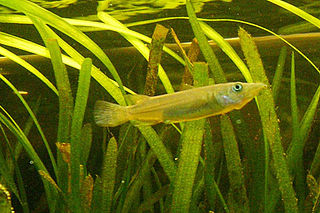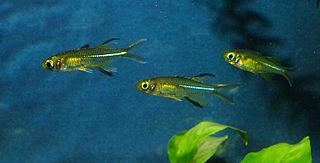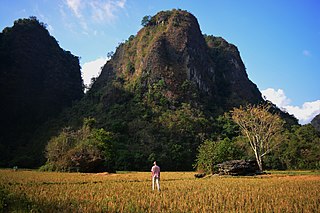
Sulawesi, also known as Celebes, is an island in Indonesia. One of the four Greater Sunda Islands, and the world's eleventh-largest island, it is situated east of Borneo, west of the Maluku Islands, and south of Mindanao and the Sulu Archipelago. Within Indonesia, only Sumatra, Borneo, and Papua are larger in territory, and only Java and Sumatra have larger populations.

Clarias is a genus of catfishes of the family Clariidae, the airbreathing catfishes. The name is derived from the Greek chlaros, which means lively, in reference to the ability of the fish to live for a long time out of water.

Nomorhamphus is a southeast Asian genus of viviparous halfbeaks from streams, rivers and lakes in Sulawesi (Indonesia) and the Philippines. They are all viviparous, producing small clutches of around a dozen fry about 10 to 15 mm long at birth. Females are generally larger than the males. In the largest species, such as Nomorhamphus liemi, the females typically reach about 10 cm (3.9 in) in length, whereas the males reach about 6–7 cm (2.4–2.8 in) in length. Males are also more brightly coloured than the females. Compared with many other halfbeaks, the lower mandible, or beak, is relatively short, on females in particular barely protruding beyond the length of the upper mandible. The males of some species have short, straight beaks, but those of others have short beaks that curve downwards forming a shape often compared to a goatee beard by aquarists. N. aenigma is unique within Nomorhamphus because of its lack of lower jaw elongation.

The viviparous brotulas form a family, the Bythitidae, of ophidiiform fishes. They are known as viviparous brotulas as they generally bear live young, although there are indications that some species do not. They are generally infrequently seen, somewhat tadpole-like in overall shape and mostly about 5–10 cm (2–4 in) in length, but some species grow far larger and may surpass 60 cm (2 ft).

Oreonectes is a genus of fish in the family Nemacheilidae found in the rivers and caves of Asia. Many of these species are troglobitic.
Eleotris vomerodentata is a species of fish in the family Eleotridae endemic to Madagascar, where it is only known to occur in fresh waters. This species can reach a length of 7.8 cm (3.1 in). Eleotris have similar features, generally, but there are ways to distinguish an Eleotris vomerodentata. The head, preoperculum, body and abdomen are beige to light brown. The fins are whitish-beige in color. The most common distinguishing feature is the presence of teeth in the vomer.

Melanotaenia is a genus of rainbowfish from Australia, Indonesia, New Guinea, and nearby smaller islands.

Oryzias is a genus of ricefishes native to fresh and brackish water in east and south Asia. Some species are widespread and the Japanese rice fish is commonly used in science as a model organism, while others have very small ranges and are threatened. They are small, up to 8 cm (3.1 in) long, and most are relatively plain in colour.

Oxyeleotris is a genus of sleeper gobies mostly restricted to Australia and New Guinea, though some are found in Southeast Asia.

Telmatherina is a genus of sailfin silversides endemic to the Indonesian island of Sulawesi. They are restricted to the Malili Lake system, consisting of the large Matano and Towuti, and the small Lontoa (Wawantoa), Mahalona and Masapi. They are also found in rivers and streams that are part of this lake system.

The Telmatherininae, the sail-fin silversides are a subfamily of atheriniform fish from the rainbowfish family, the Melanotaeniidae, inhabiting fresh and brackish water. All but the species Kalyptatherina helodes are restricted to the Indonesian island of Sulawesi, and most are found solely in the Malili Lake system, consisting of Matano and Towuti, and the small Lontoa (Wawantoa), Mahalona and Masapi.

Cavefish or cave fish is a generic term for fresh and brackish water fish adapted to life in caves and other underground habitats. Related terms are subterranean fish, troglomorphic fish, troglobitic fish, stygobitic fish, phreatic fish and hypogean fish.

Bantimurung-Bulusaraung National Park is a national park in South Sulawesi in Indonesia. The park contains the Rammang-Rammang karst area, the second largest karst area known in the world after the one in South-Eastern China.
Diancistrus is a genus of viviparous brotulas.

The caves in the Maros-Pangkep karst are situated in South Sulawesi, Indonesia, and contain paintings from the Paleolithic considered to be the earliest figurative art in the world, dated to at least 43,900 years ago.
Kryptopterus piperatus is a species of Asian glass catfish from rivers in northern Sumatra, Indonesia. It was first described in 2004. True K. piperatus is rarely seen in the aquarium trade, while K. vitreolus is common.
Belobranchus segura is a species of eleotrid sleeper goby which has been found in Indonesia on Halmahera, in Papua Barat and also on the Solomon Islands. It is an anadromous species in which the eggs are laid over rocky and gravel bottoms in freshwater streams. The free-swimming larvae then drift downstream to the sea where they undergo a planktonic stage before migrating up streams to mature and breed. It feeds on small crustaceans and fish. The specific name honours the French hydrobiologist Gilles Segura for his contribution to the study of fish faunas.
Platygobiopsis hadiatyae is a species of goby, commonly known as a Renny's flat goby.
Scorpaenopsis rubrimarginata is a species of venomous marine ray-finned fish belonging to the family Scorpaenidae, the scorpionfishes. This species is found in the Western Indian Ocean.












